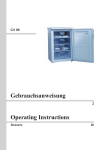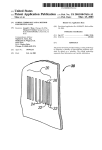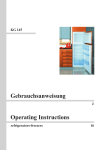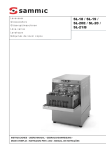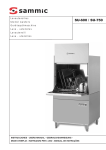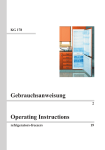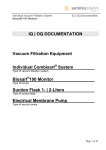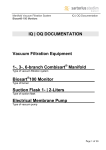Download Gebrauchsanweisung Operating Instructions
Transcript
KS 123 Gebrauchsanweisung 2 Operating Instructions refrigerators 15 Operating Instructions refrigerators KS 123 List of contents Safety instructions................................................................................................................18 Characteristics of the appliance..........................................................................................19 Preparation for use...............................................................................................................20 How to operate the appliance..............................................................................................22 Maintenance and repairs......................................................................................................23 The manufacturer may introduce changes in external and internal outlook of the appliance which do not influence its functioning and safety, e.g. shape of the door handle, the glass shelf design etc. 16 Dear Customer, Your new appliance comes from our new family of refrigerators which is characterized by modern functional solutions, soft plastic form and subtle design. Read this user handbook thoroughly. It will help you discover, while reading the handbook and getting acquainted with the appliance, the advantages of a refrigerator coming from this new line, and strengthen your conviction about the refrigerator being a beneficial purchase. High quality of our products is based on the following modern technical solutions: * the appliance is completely ecologically clean – neither the refrigerating medium, the structural materials nor the production process contain any environmentally harmful substances, * our “fresh line +” is not just elegant form, but also a streamlined body which makes it easier to keep the refrigerator sterilely clean – no habitat is provided for fungi and bacteria, * adjustment of distance between the shelves by means of the so-called “Volta system” makes it possible to adjust them to the height of the products and, besides, to place the shelves at an angle (to store bottles in a safe way), * solid insulation of the refrigerators makes it possible to achieve very high energetic efficiency and, therefore, very low power consumption, * refrigerator compartment defrosts automatically, therefore cleaning operations are reduced to periodical washing, * containers for vegetables are very spacious, and due to their streamlined shape are very easy to keep clean, * optimum arrangement of internal lights provides perfect lighting of the entire compartment and does not blind the user. Aesthetical execution, selection of graphic elements and colours elicit positive visual feelings, while technical and operational values guarantee convenient use. We wish you maximum satisfaction with the use of the refrigerator 17 Safety instructions The manufacturer shall not be responsible for any damage resulting from nonobservance of the principles included in this instruction, therefore it is important to read carefully the information about safety, operation and maintenance of the refrigerator. * Keep this handbook for future consultation or pass it on to the next user, if any. Before using the appliance * Do not hold the door handles, pull by the condenser at the back or touch the compressor unit while positioning, shifting or lifting the refrigerator. * The refrigerator operates properly at the ambient temperature between +10°C and +32°C. It should not be used in a basement, a hall or in an unheated summer cottage in autumn or winter. Wait at least two hours after positioning the appliance at the appointed place before switching it on. * * Be careful to prevent children from using the appliance inattended. Do not let children play with the appliance. Children are forbidden to hang on to the door. * Audible crackling sounds are caused by expansion and shrinkage of parts due to temperature changes. * Disconnect the plug from the mains socket before any maintenance operation – do not pull the cord but hold the plug body. * For reasons of safety do not repair the appliance on your own. Any repairs performed by persons not properly qualified may endanger the users. * If the appliance is not going to be used again it should be made unusable before scrapping by cutting off the power cord. * The packaging materials (bags, pieces of styrofoam etc.) should not be left within the reach of children. * In case of any damage to the refrigerating system ventilate the room where the appliance is situated for several minutes (the room must be at least 4 m3). * Any contact of the refrigerant from the damaged refrigeration system with the eyes may cause injury. * Do not switch on a damaged appliance. * The refrigerator shall not be transported on its side or inclined from vertical by more than 40° during transport, handling or positioning. If a situation like that occurs, the refrigerator can be switched on after at least 2 hours from positioning. 18 Characteristics of the appliance The refrigerators (Fig. 1) are electrical appliances for domestic use. The refrigerator compartment should be used exclusively for storage of fresh food products. The refrigerators are designed for operation at the ambient temperature of +10°C to +32°C. In this appliance all the elements of the refrigerating system are situated behind the back wall of the compartment This arrangement increases capacity of the compartment, facilitates cleaning it, extends life of the refrigerating system (protects it against possible damage). The shelves are made of safe hardened glass (Fig. 2). They can be washed in a traditional way or in dishwasher machines. The special construction of the frames of glass shelves (Fig. 2) makes it possible to adjust distances between adjacent shelves. To change the distance between the shelves * take out the shelf * remove the frames * replace the frames in a new position at a bigger or smaller distance from the next shelf, as required. Figures 3 and 4 illustrate 2 possibilities of installing the shelves in the refrigerator * decreasing the distance between the shelves (Fig. 3) * increasing the distance between the shelves (Fig. 4). Removing and installing the shelves * * In order to take out a shelf hold it with your right hand at the right hand side and lift the left hand side with your left hand to about 45° angle and then take out from the compartment (Fig. 5). When taking out the shelves for washing start with the top shelf, and put them back again starting from the bottom shelf. * The shelves are installed as follows: * - place the shelf inside the compartment inclined at 45° angle (like when taking out) the projections of the shelf frames shall be placed in recesses in the compartment walls. Technical data: Height: Width: Depth: Net capacity: Weight: Supply voltage: Total rating power: Defrosting: KS 123 1220 mm 558 mm 540 mm 203 l 45 kg 230 V ~50 Hz 90 W automatic Equipment: glass shelf in a frame glass shelf container for vegetables door tray tray cover support plate for eggs build-in kit KS 123 5 pcs 1 pce 1 pce 4 pcs 1 pce 2 pcs 1 set 19 Preparation for use Installing the appliance * Unpack the appliance, remove adhesive tapes securing the door and equipment. Any glue residues can be removed with a mild cleaning agent. * Do not throw out the styrofoam packaging elements. If the refrigerator has to be transported again, it shall be packaged in the styrofoam elements and plastic foil and secured with adhesive tape. * Wash the interior of the refrigerator and the equipment elements with tepid water with addition of dishwashing agent, then wipe and dry. * Install the refrigerator in a dry,well-ventilated place, protected from sunlight, away from heat sources like kitchen cookers, central heating radiators etc. If installing near a heat source cannot be avoided, use an appropriate insulating plate or conform to the following minimum distances: - from electric, gas or other cookers – 3 m - from oil or coal stoves – 30 cm. * In case of installing adjacent to another refrigerator or freezer it is necessary to maintain the minimum side clearance of 2 cm. * Make sure the appliance is level by appropriately turning 2 adjustable front feet. * After installation make sure that the appliance does not rest on the power cord. * In order to guarantee free opening of the door the distance between the side wall of the appliance (with the hinges) and the wall of the room shall be at least 5 cm. * Any handling of the parts of the refrigerating unit is forbidden. Special care should be used to avoid any damage to the capillary tube (Fig. 6 (1)) visible in the compressor recess. The tube shall not be bent, straightened or coiled. * Any damage to the capillary tube caused by the user shall result in loss of warranty rights. Earthing of the appliance is required by law. The manufacturer rejects any responsibility for damage to persons or property due to lack of observance of that requirement. * Do not use any adapter connectors, distributor connectors, two-wire extension cords. If it is necessary to use an extension cord, it has to be a single-socket cord with a protective plug, covered by a safety certificate. * If an extension cord (with a protective plug, covered by a safety certificate) is used, its socket shall be placed at a safe distance from kitchen sinks, protected against flooding with water, sewage, fluids boiling over from vessels placed on cookers. 20 Preparation for use * If the power cord gets damaged it should be replaced by a properly qualified person. * The data of voltage and consumed power are presented at the rating plate situated at the bottom of the compartment wall. Connection to the power supply * Before connecting to the power supply set the temperature adjustment knob to “0”. * The appliance shall be connected to 220-230 V AC, 50 Hz mains by means of a properly installed electric socket, earthed and protected by 10 A fuse. In case the user intends to store for refrigeration on the door balconies products weighing in total more than 20 kg, it is necessary: to assemble the back holder to the door in the way shown on the design: in accordance with dimensions on the diagram: slide the refrigerator towards the wall, when assembling the holder to the door apply tap screws without spacing sleeves 1. Wall 2. Back holder 3. Top view 21 How to operate the appliance Temperature adjustment * There are 8 possible settings of the refrigerator knob: “0” – the appliance is off “1” – highest temperature in the refrigerator (warmest) “2” – “6” – intermediate settings “7” – lowest temperature in the refrigerator (coldest) * Do not fill the refrigerator compartment with products before it is cooled down. Storage of products in the refrigerator * Products shall be placed on plates, in containers or packaged in plastic foil. Distribute the products uniformly over the entire surface of the shelves.. Be careful to avoid food products touching the back wall, since it may cause frosting or wetting of the products. * Do not place vessels with hot contents in the refrigerator. * Products which easily absorb foreign smells, like butter, milk, cottage cheese, and those which emit strong smells, like fish, cured meat, cheese – should be placed on the shelves packaged in foil or in tight containers. * Food products should be stored in appropriate cooling areas according to their type and sensitivity. When placing food products inside the compartment please consult the photograph. * Vegetables should be dried thoroughly before placing in the refrigerator. Too much moisture reduces storage time of vegetables, particularly the leafy ones. * Vegetables should not be washed before placing in the refrigerator. Washing removes natural protective barriers, therefore it is recommended to wash vegetables immediately before use. * Storing vegetables with high water content causes condensate formation above the vegetable container; this will not affect the appliance’s efficiency. * Note! Do not allow direct contact of oil and fats with plastic elements or the door seal. Defrosting the refrigerator Frost forms on the back wall of the refrigerator compartment. It is removed automatically. In the course of defrosting impurities may get into the drain hole together with defrost water. This may cause clogging of the drain. In such case the drain can be carefully cleared with a forcing device (Fig. 7). The appliance operates in cycles: it cools (then frost settles on the back wall), then it defrosts (water flows down the back wall). * Before cleaning operations cut off power supply by taking the plug from the socket, 22 How to operate the appliance switching off or screwing out the fuse. When taking the plug from the socket do not pull the cord but hold the plug body. * Do not allow water to enter the control panel or lighting devices. * We do not recommend the use of defrosting aerosols. They may cause explosive gas mixtures to form, or they may contain solvents which damage plastic parts of the appliance, and they may even be dangerous to your health. * Be careful to avoid cleaning water going down the drain hole to the evaporator container (Fig. 7). Use a moist foam or piece of cloth, not dripping with water. * The entire appliance can be washed with water and mild detergent except the door seal. Cleaning agents containing abrasive substances or acids should be avoided. The door seal should be cleaned with pure water and wiped dry. Maintenance and repairs Replacement of a light bulb * Set the knob to “0”, then take out the plug from the mains socket. * Using a cross screwdriver unscrew the screw holding the bulb cover and take it off (Fig. 8). * Replace the bulb with a new one of the following parameters: 220-240 V, max. 15 W, E14 thread. Maximum bulb dimensions: diameter – 26 mm, length – 55 mm. * Install and fix the bulb cover (Fig. 9). * Important: do not use light bulbs of higher or lower power rating, use only light bulbs of the parameters as above. How to save energy? * Position the refrigerator away from sources of heat (e.g. heat radiators or cookers (Fig. 10). * Guarantee air circulation around the refrigerator. * Dishes should be cooled down to room temperature before placing in the refrigerator. * Keep the door open for a short time while taking the food in and out of the refrigerator. * Change the position of the knob according to the degree of filling the refrigerator with products. Before a prolonged period of disuse: * Set the temperature regulator knob to “0”, then take out the plug from the mains socket. * Empty the refrigerator compartment. * Wash and dry the interior of the refrigerator. Wash thoroughly all the elements of the equipment (vegetable containers, trays, glass shelves, shelf frames). * Leave the refrigerator door slightly open to avoid appearance of unpleasant odours. 23 Maintenance and repairs Making any repairs on your own beside those mentioned in the table below shall result in the loss of warranty rights. Symptoms The appliance is not working Cause Remedy Break in the electric circuit - check if the plug is correctly inserted in the mains socket, - check voltage in the socket by plugging in another device, e.g. a night lamp, - check if the power cord is not damaged Compressor seldom turns on - check if the ambient temperature is not lower than +10°C The light inside the compartment is not working Light bulb loose or burned out. - check the previous point first (the appliance is not working), - screw in or replace the burned out bulb Temperature inside the compartment is not low enough (compressor works continuously) The doors do not close properly or are being opened too often - place products in such a way that they do not prevent closing the door - shorten the time of opening the door Ambient temperature is higher than +32°C - the appliance is designed for operation in temperatures from +10°C to +32°C Air circulation at the rear of the appliance is blocked - move the appliance away from the wall The appliance stands in direct sunlight or near heat sources Water collects at the bottom of the refrigerator compartment The appliance is excessively noisy 24 - change location of the appliance Food products touch the - move products or containers away back wall of the refrigerator from the back wall Drainage hole is blocked - take out the forcing device and clear the condensate drain The appliance is not level - level the appliance The appliance is in contact - position the appliance without contact with furniture, other objects with other objects Operational notes Various noises may appear in the course of normal operation of the appliance. They have no influence on correct operation of the refrigerator. Noises which are easy to liquidate: * noise when the device is not standing vertically – adjust the position by means of the adjustable feet in front. It is possible to place some soft material under the rollers in the rear, especially if the floor is made of tiles, * rubbing against adjoining piece of furniture – move the refrigerator-freezer away, * creaking of drawers or shelves – remove the drawer or shelf and install it again, * sounds of bottles touching one another – move the bottles away from one another. Sounds which may be heard during normal use of the refrigerator result from operation of the thermostat, the compressor (switching on) or the refrigerating system (expansion and shrinkage of material due to temperature changes and flow of the refrigerating medium). Disposing of the device When disposing of the device, do not bring it to regular municipal waste containers. Instead, bring it to electrical and electronic waste recycling and reuse center. A relevant label has been put on the device, its instructions manual, or on the package. The device has been manufactured of recyclable materials. By bringing old device to recycling collection center, you show that you care about nature. Ask your local environmental care authority for information on location of such facilities. THE APPLIANCE ASSEMBLY IN A FURNITURE NICHE IS TO BE CARRIED OUT ACCORDING TO THE FOLLOWING „FURNITURE BUILD-IN ASSEMBLY INSTRUCTION”: for the appliance types KS 123 25 1 Zchng. 1 Bild 2 Bild 3 Bild 4 Bild 5 1 Bild 7 Bild 6 Bild 8 Bild 9 NEIN Bild 10















